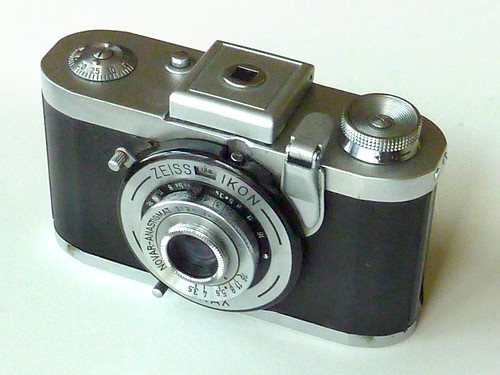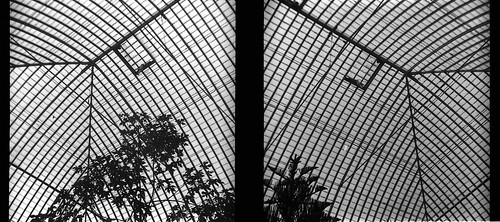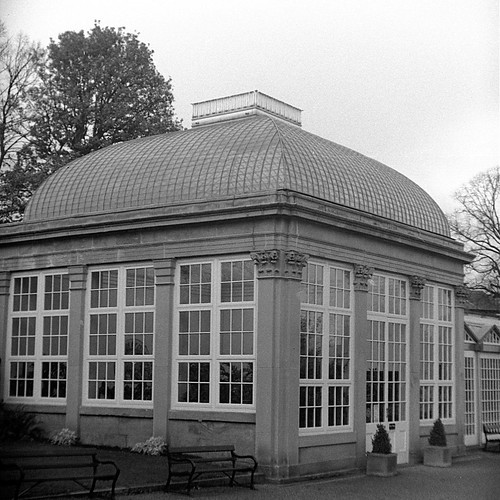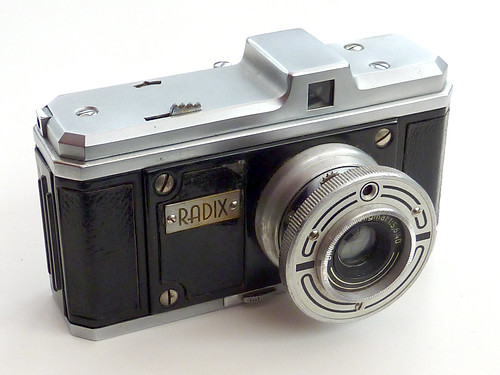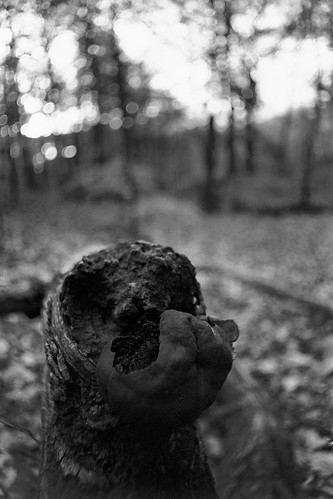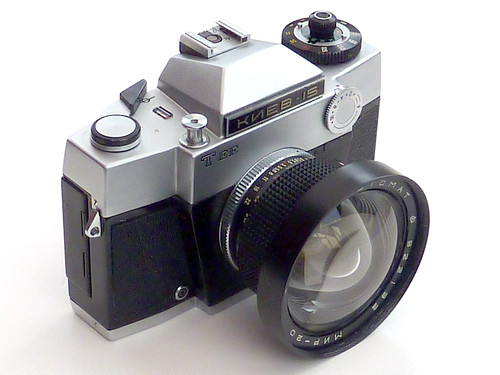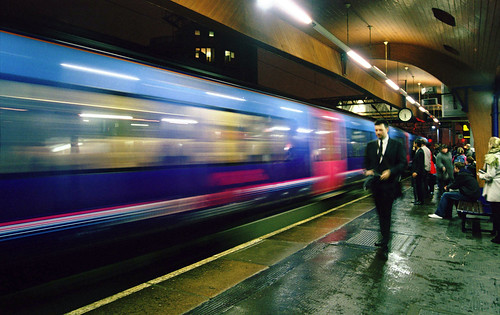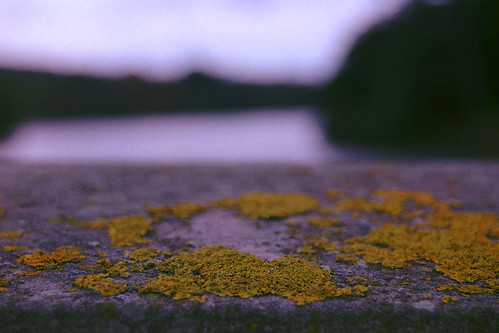I'm sticking with the 35mm square format this week, the Tenax I takes 24mm square negatives, and the film is advanced using the lever next to the lens, which also cocks the shutter.
The Tenax I was first produced in 1931, but this is one of the post war examples made in the late 1940s.
Saturday 27 November 2010
Thursday 25 November 2010
photo from week 47 - Bilora Radix

reflected self-portrait with Bilora Radix camera and crumpled plastic witch's hat, originally uploaded by pho-Tony.
Friday 19 November 2010
Week 47 - Bilora Radix
This camera was made in Germany in the late 1940s, it uses the Agfa Rapid (or Karat) system, in which 35mm film is loaded into a spool free cassette, and advanced by direct driving of the sprockets into another cassette. The most common image size is 24mm square, as used in this camera, but there were also half frame (see week 33), and full 24mm x 36mm cameras.
I've loaded approximately half of a 36 exposure roll of Rollei Retro black and white film into an old Agfa Rapid cassette.
I've loaded approximately half of a 36 exposure roll of Rollei Retro black and white film into an old Agfa Rapid cassette.
Saturday 13 November 2010
Week 46 - Pentax Auto 110
For a couple of decades, this little camera and it's set of lenses were what I used for day to day photography, holidays, family occaisons etc.
I bought it new in 1981, there were various "kits" available, I had the one with the 18mm, 24mm and 50mm lenses, a motor drive and flash unit. There were more extensive kits including a whole range of filters and close up lenses.
Over the years I acquired the 70mm and 20-40mm zoom lenses, together with various close up lenses, and even a third party tele-converter.
I last used it nearly 10 years ago, and the film I have expired in 2003, but I hope to get something out of it. With a new set of batteries, after a few hesitant exposures, it seems to be fully working.
There are still several mail-order firms that process 110 film, even though the format is no longer manufactured (though there are rumours that this may change.)
I'll try to use the 24 exposures next week and get it in the post by the weekend, but it will be a little longer than usual before I can upload the results.
I bought it new in 1981, there were various "kits" available, I had the one with the 18mm, 24mm and 50mm lenses, a motor drive and flash unit. There were more extensive kits including a whole range of filters and close up lenses.
Over the years I acquired the 70mm and 20-40mm zoom lenses, together with various close up lenses, and even a third party tele-converter.
I last used it nearly 10 years ago, and the film I have expired in 2003, but I hope to get something out of it. With a new set of batteries, after a few hesitant exposures, it seems to be fully working.
There are still several mail-order firms that process 110 film, even though the format is no longer manufactured (though there are rumours that this may change.)
I'll try to use the 24 exposures next week and get it in the post by the weekend, but it will be a little longer than usual before I can upload the results.
Thursday 11 November 2010
photo from week 45 - Kiev-15 TEE
Scan of five consecutive frames, each taken with a different lens. See the Flickr caption for details.
photo from week 45 - Kiev-15 TEE
Stainborough Castle, which is a folly built in the grounds of Wentworth Castle. Taken woth the Mir-20 20mm lens.
photo from week 45 - Kiev-15 TEE
This one was taken with the Mir-1 37mm lens which focuses down to 24cm, at near full aperture the background trees are out of focus.
photo from week 45 - Kiev-15 TEE
Most of the photos this week were taken with the Mir-20 20mm wide-angle lens. This lens can focus very close, and at near full aperture the backgound is comfortably out of focus.
Friday 5 November 2010
Week 45 - Kiev 15 TEE
The Kiev 15 was made in the soviet union in the 1970s, this one dates from 1977. They were not made for export, and are quite unusual outside the Eastern Bloc. This one came with five lenses, including the 20mm Mir-20 pictured, the others are 37mm, 53mm, 85mm and 135mm. The lenses use a bayonet mount peculiar to this and the previous Kiev 10 model, later models, eg the Kiev 17 went on to use the Nikon mount for greater compatibility.
The aperture is set with a dial on the camera body, and there is no way to set the diaphragm directly on the lens, so even if adaptors were available, these lenses would be of very limited use to someone without the correct camera. That probably accounts for the relatively low price of these systems. The metal focal plane shutter has an unusual fan arrangement, which I have not seen on any other cameras. This is a heavy camera, and feels solid, but with fairly basic engineering standards, changing the lenses for example involves quite a lot of gentle persuasion!
I've loaded it with a roll of Rollei Retro black and white film.
The aperture is set with a dial on the camera body, and there is no way to set the diaphragm directly on the lens, so even if adaptors were available, these lenses would be of very limited use to someone without the correct camera. That probably accounts for the relatively low price of these systems. The metal focal plane shutter has an unusual fan arrangement, which I have not seen on any other cameras. This is a heavy camera, and feels solid, but with fairly basic engineering standards, changing the lenses for example involves quite a lot of gentle persuasion!
I've loaded it with a roll of Rollei Retro black and white film.
photo from week 44 - Minolta Dynax 5
Rush hour at a very wet Oxford Road Station in Manchester, the camera was on aperture priority, at around f5.6, and I braced it against a pillar for the exposure which was around 1 second.
photo from week 44 - Minolta Dynax 5

reflected self-portrait with Minolta Dynax 5 and asian conical hat, originally uploaded by pho-Tony.
photo from week 44 - Minolta Dynax 5
Taken at "Fright Night" in Sheffield city centre, I manually set the shutter speed to 1.5 seconds and the aperture to f11, with the flash forced to fire.
photo from week 44 - Minolta Dynax 5
Using the closest possible focussing distance, and the widest aperture, this was taken on the bridge at Compton Verney, lichen in the foreground and the lake and trees very blurry in the background.
Subscribe to:
Posts (Atom)
